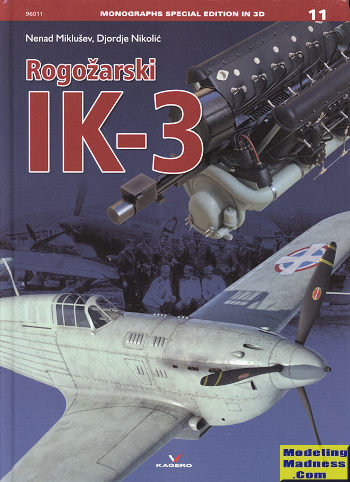Kagero's Rogožarski
IK-3
|
Author: |
Nenad Miklušev
and Djordje Nikolić Majsak |
|
Publisher |
Kagero |
|
Price |
$37.95 from
www.casematepublishing.com |
|
Reviewer: |
Scott Van Aken
|
|
Notes: |
Monograph Special Edition in
3D, 184
pages.
ISBN 978-83-65437-80-8 |
 It would not
be far from wrong to say that in general, eastern Europ in the late 1930s was
not quite as technically advanced as western Europe of the time. There were
several reasons for this. One was the slowness of transitioning from an agrarian
to technical society. Often a lack of available skills and funding were root
causes. It was also not uncommon for leadership to be quite ingrained in 'what
was' to the extent of stifling progress in this area.
It would not
be far from wrong to say that in general, eastern Europ in the late 1930s was
not quite as technically advanced as western Europe of the time. There were
several reasons for this. One was the slowness of transitioning from an agrarian
to technical society. Often a lack of available skills and funding were root
causes. It was also not uncommon for leadership to be quite ingrained in 'what
was' to the extent of stifling progress in this area.
The kingdom of Jugoslavia was one of
those fairly new nations that came into being as a result of the end of WWI. It
basically had to start from scratch in terms of building a military and the
infrastructure, both military and civilian to support it. The road to
modernization was rocky, but not impossible. The country did have a an aviation
industry, though it was not at the same level of say France and Italy. Indeed,
other nations were relied upon for components such as engines and instruments
and guns. Even those home produced were built under license.
The nation was not lacking in talented
designers as is evident with the product of this book. The IK-3 was the result
of a need for a modern fighter and the inability to purchase their needs from
overseas. If you think it looks like a Hurricane, you'd be pretty close as the
aircraft was constructed in much the same way as the Hawker product. It even
used a Hurricane windscreen/canopy after issue were found with the Rogozarski
built version used in the initial production planes.
Like all aircraft, there were teething
troubles and lack of funding kept the numbers produced low. Aircraft were still
coming off the production lines when the Germans invaded and took over the
nation. The IK-3 pilots put up a sprited defense, but lack of pilot and airframe
protection usually meant that when planes were damaged, they tended to stay that
way until the end of what was a short campaign.
Post war, the IK-3 provided the basis of
Jugoslavia's post war fighter, the S-49. This aircraft was kept in service until
the very late 1950s when the nation received its first jets, after which the
type quickly disappeared.
Typical
of this series, the very large book has a full history of the type and its
development as well as its use in battle. There are lots of scale planes and
profile drawings showing the differences in variants, including a very large
fold out in 1/32 scale for those who might want to scratch build one.
The rest of the book is basically
artwork. There are color profiles at the end of the book and in between that and
the scale drawings are 3D works that show various areas of the aircraft both
with and without the exterior framing. All areas of the aircraft both inside and
out are provided in these views, a most helpful feature for the detail modeler
or those who just like a lot of information. It is the best book on the subject
I have yet read and one I have no trouble recommending to you.
Novembetr 2018
Review book courtesy of the fine folks at
www.casematepublishing.com. You
can get yours at
this link.
If you would like your product reviewed fairly and
fairly quickly, please contact
the editor or see other details in the
Note to
Contributors.
 It would not
be far from wrong to say that in general, eastern Europ in the late 1930s was
not quite as technically advanced as western Europe of the time. There were
several reasons for this. One was the slowness of transitioning from an agrarian
to technical society. Often a lack of available skills and funding were root
causes. It was also not uncommon for leadership to be quite ingrained in 'what
was' to the extent of stifling progress in this area.
It would not
be far from wrong to say that in general, eastern Europ in the late 1930s was
not quite as technically advanced as western Europe of the time. There were
several reasons for this. One was the slowness of transitioning from an agrarian
to technical society. Often a lack of available skills and funding were root
causes. It was also not uncommon for leadership to be quite ingrained in 'what
was' to the extent of stifling progress in this area.